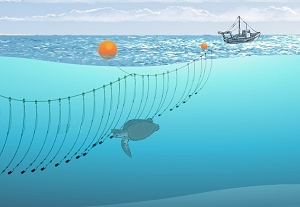Commercial Longline Fisheries

The Problem: Each year, foraging and migrating sea turtles are accidentally captured, injured
 Scientists estimate that thousands of sea turtles are captured around the world by longline hooks every year. Many of these animals die from drowning or from their injuries after release. Most longline fishing occurs in the open ocean (pelagic longlining) in the top 975 feet of water but in some areas, such as the Gulf of Mexico, fishermen also set longlines on the ocean floor (bottom longlining).
Scientists estimate that thousands of sea turtles are captured around the world by longline hooks every year. Many of these animals die from drowning or from their injuries after release. Most longline fishing occurs in the open ocean (pelagic longlining) in the top 975 feet of water but in some areas, such as the Gulf of Mexico, fishermen also set longlines on the ocean floor (bottom longlining).
Species Affected: All sea turtles are affected by commercial fisheries, but loggerheads and leatherbacks are at greatest risk from longline fisheries because of their feeding habits.
The Solution: :
* Become a conscientious consumer and make ocean-friendly seafood choices with guidance from Seafood Watch at the Monterey Bay Aquarium, the only sustainable seafood site we recommend;
* As you learn about this issue, spread the word to family and friends;
* Become an activist and support STC action alerts on fisheries.
Case Study: In 2004 scientists at Duke University estimated that 250,000 loggerhead and 60,000 leatherback turtles are accidentally captured each year by commercial longline fishing. This study, the first global assessment of the problem, also reported that U.S. restrictions on fishing only account for about two percent of longline fishing and loggerhead turtles are 10 times more likely to get caught than leatherbacks.
As a result of advocacy and legal action by U.S. conservation groups, the United States has become a global leader in reducing the capture of sea turtles and other non-target species in longline fisheries. During the last decade, NOAA Fisheries, sea turtle scientists
Related links:
* NOAA, Industry Develop Technology That Saves Sea Turtles
* Emergency Action Implemented for Threatened and Endangered Sea Turtles
* Groups Sue National Marine Fisheries Service to Protect Sea Turtles
* STC Prepares for Legal Action over Bottom Longline Fishing in the Gulf of Mexico
Mumu






